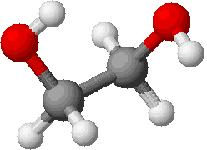Ethanediol, 1D at O
 | |
|---|---|
| Species tag | 063517 |
| Version | 1* |
| Date of Entry | Jun. 2025 |
| Contributor | H. S. P. Müller |
|
Two distinct OD isotopomers exist, which interact,
but no tunneling occurs. The aGg' conformer
is the one lowest in energy. State number 0 refers
to the ODOH variant (D is involved in a hydrogen bond
to the 2nd O atom and H is dangling), whereas state
number 1 refers to the OHOD variant, in which D and H
have exchanged their roles.
The experimental transition frequencies were summarized
by | |
| Lines Listed | 28993 |
| Frequency / GHz | < 600 |
| Max. J | 60 |
| log STR0 | -9.5 |
| log STR1 | -6.0 |
| Isotope Corr. | |
| Egy / (cm–1) | 0.0, 21.743 |
| µa / D | 2.08 |
| µb / D | 0.94 |
| µc / D | -0.47 |
| A / MHz | 14620.25 / 15126.69 |
| B / MHz | 5548.42 / 5311.10 |
| C / MHz | 4517.883 / 4412.167 |
| Q(300.0) | 88025.6751 |
| Q(225.0) | 56192.2815 |
| Q(150.0) | 29599.9248 |
| Q(75.00) | 9569.9880 |
| Q(37.50) | 2921.9381 |
| Q(18.75) | 855.4656 |
| Q(9.375) | 263.9439 |
| Q(5.000) | 100.0711 |
| Q(2.725) | 40.6672 |
| detected in ISM/CSM | no |